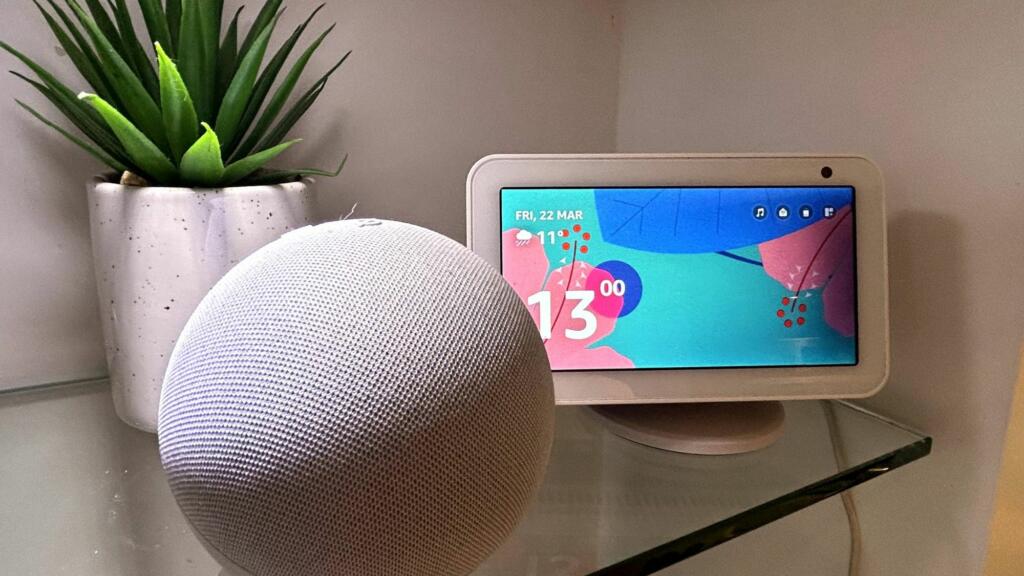
What is a smart speaker and how do they work?
Alistair Charlton
Unsure which type of speakers to buy? This guide will walk you through the similarities, differences, pros and cons of each option.
When deciding to buy new music speakers, there are two distinct options to pick from. Before you consider price, size, design and functions, you need to decide whether you want Bluetooth speakers or smart speakers.
Clearly defining how the two differ can be confusing, especially since the best smart speakers often have Bluetooth, and some Bluetooth speakers can be considered smart.
A handful of products can be described as both, but generally speaking there are clear ways to differentiate one from the other. Understanding these differences will help you decide which type of speakers to buy.
When deciding to buy new music speakers, there are two distinct options to pick from. Before you consider price, size, design and functions, you need to decide whether you want Bluetooth speakers or smart speakers.
Clearly defining how the two differ can be confusing, especially since the best smart speakers often have Bluetooth, and some Bluetooth speakers can be considered smart.
A handful of products can be described as both, but generally speaking there are clear ways to differentiate one from the other. Understanding these differences will help you decide which type of speakers to buy.
 Credit: Shutterstock/David9182
Credit: Shutterstock/David9182Both of these product categories cover a broad price range, from two to three or even four figures in some cases, but the majority are priced between £50 to £300.
Popular producers of Bluetooth speakers include JBL, Ultimate Ears, and Bang & Olufsen, while the smart speaker market mostly consists of products from Amazon, Apple, Sonos and Google’s Nest division.
In the simplest possible terms, smart speakers have an internet connection and a voice assistant (like Alexa, Siri or Google Assistant), while Bluetooth speakers do not.
There are some exceptions to this rule, such as the Sonos Roam, which works as a Bluetooth speaker when running on battery power but becomes a smart speaker when plugged into the mains and connected to your wi-fi network.
One thing to consider when looking at Bluetooth speakers vs smart speakers is where they get their music from. Bluetooth speakers connect directly to devices like smartphones, tablets and computers, using Bluetooth. They then play whatever sound that device is producing, such as music played through your phone, or a podcast playing on your computer.
The speakers aren’t connected to the internet and are controlled either by the input device (such as your phone), or with its own buttons, which are often limited to basic functions, like volume control and play/pause.
 Credit: Sonos
Credit: SonosOn the other hand, smart speakers connect to the internet via your wi-fi network. They can be controlled by a smartphone or computer, but that device is simply telling the speaker where to get the music, podcast or radio station from, rather than sending data to it.
Smart speakers also have a voice assistant that is controlled by you saying a ‘wake word’ (such as “Alexa” or “Hey Google”), and issuing a command (like “play Radio 2”). Smart speakers can also be used to control smart home devices like light bulbs, plugs, thermostats and other products connected to the internet.
Bluetooth speakers are usually smaller, battery-powered and more portable than smart speakers, which tend to be bigger and are almost always powered from the mains.
Some smart speakers have Bluetooth and can be used as a Bluetooth speaker, playing music directly from your phone, but they lack the portability of a dedicated Bluetooth speaker.
 Credit: Amazon
Credit: AmazonAs we said earlier, prices of Bluetooth speakers can vary significantly. At the very bottom of the market you can pick up a small speaker on Amazon for about £20, and there are even options from reputable brands like Anker starting at the £30 mark.
These won’t fill the room with powerful, high-quality sound, but for a small bedroom or to use in the garden or at a picnic, they are a good option.
Spending around £100 gets you a range of options from JBL and Ultimate Ears, with some even being waterproof. Battery life at this price tends to be between ten and 20 hours, depending on volume they’re played at.
At the very top of the market you’ll find mains-powered speakers with Bluetooth as a connectivity option. These include stylish and high-end sound systems from Naim and Bowers & Wilkins.
If you want room-filling, statement speakers with the practicality of Bluetooth but without the smartness of a voice assistant (and no option for wireless, battery power), this is where your money can be spent.
 Credit: Apple
Credit: AppleSmart speakers start at £50 for the Amazon Echo Dot (5th-generation) or Nest Mini, rising to around £100 for their larger Echo (4th-generation) and Nest Audio siblings, and £300 for the 2nd-generation Apple HomePod.
All of these speakers are mains powered – although battery docks are available for some models of Echo – and they have a voice assistant that requires a wi-fi connection to function.
Pricier smart speakers include the latest Era 100 and Era 300 from Sonos, at £249 and £449 respectively. These can be used on their own, or with other Sonos speakers as part of a house-wide music and smart home control system.
Broadly speaking, smart speakers have voice assistants, and Bluetooth speakers do not. This means Bluetooth speakers are controlled by the input device, such as your phone, while smart speakers can be controlled by speaking to their voice assistant.
Amazon’s Alexa, Apple’s Siri and Google Assistant all work in similar ways. They can answer questions, read out news headlines and the weather forecast, control smart home devices, like colour-changing light bulbs, manage calendars and shopping lists, set timers and alarms, make calls and play music, radio and podcasts.
All of that might sound complicated, but once you know what a voice assistant can do, the smart speaker becomes far more than just a way to play music.
 Credit: Bang & Olufsen
Credit: Bang & OlufsenBeing able to set multiple timers, each with their own name, is useful in the kitchen, while asking Alexa to check the age of that celebrity you’re talking about quickly becomes second nature.
It’s also convenient to ask for a radio station, or even a repeat of your favourite show, and the assistant can be used to adjust the volume, search for an artist or playlists, and skip to the next track.
As outlined earlier, the Sonos Roam is a rare case of a Bluetooth speaker that also has a voice assistant, in the form of Alexa and Google Assistant.
The Bang & Olufsen Beosound A1, around £240, also fits into this niche, being a battery-powered Bluetooth speaker with Alexa voice control.
There are currently only a handful of smart speakers to pick from, with the Amazon Echo, Google Nest, Sonos and Apple HomePod product families responsible for the lion’s share of the market.
Smart speakers tend to be fairly small, ranging from the tennis ball-sized Amazon Echo (5th gen) to the larger Amazon Echo Studio and Apple HomePod.
Bluetooth speakers also fit into these general dimensions, but with some that are smaller (almost pocket-sized) and some that are big, like the Bang & Olufsen A9 that stands a full 90cm (2ft 11in) tall.
Both types of speaker usually have a simple set of buttons, knobs or dials for controlling volume and media playback, and some Bluetooth speakers come with a conventional remote control. But in most cases it’s your phone or voice that’s used for the majority of interactions.
Few Bluetooth or smart speakers have displays, save for examples like the small, simple screens on Bluetooth speakers by Ruark, and the larger interfaces of smart displays like the Nest Hub and Echo Show.
 Credit: Bang & Olufsen
Credit: Bang & OlufsenA larger speaker that houses more individual speaker drivers is, in most cases, going to produce a louder, clearer sound that is more powerful and of higher quality than a smaller speaker with fewer drivers.
There are some exceptions, and it can be argued that price is equally capable of determining the audio abilities of a speaker, but generally it is true to say a bigger speaker produces better sound.
The Amazon Echo smart speaker family demonstrates this well, with the smaller and cheaper Echo Dot (5th gen) housing a single speaker driver, while the larger and more expensive Echo (4th gen) contains three drivers – a woofer and two tweeters – and produces a better sound with greater volume.
Some Bluetooth speakers, including several models of JBL, can be wirelessly connected to create a larger sound system. So, too, can smart speakers, which can be turned into a whole-home audio system.
Many smart speakers, including those from Amazon, Apple and Google, can be made into a stereo pair, producing a wider field of sound with clearly defined left and right channels – perfect for placing either side of a record player.
 Credit: Exceptional
Credit: ExceptionalPicking between Bluetooth speakers and smart speakers mostly comes down to whether you want a voice assistant or not. Bluetooth speakers tend not to have these, and instead simply play whatever sound they are fed, whether that be from a phone, tablet or other music system.
They vary greatly in terms of price, size, design and music capabilities, and there are many more Bluetooth speakers options than smart speakers.
Smart speakers, with their internet connection and voice assistant, can be used to play music too, but also much more besides. If you want a voice assistant to answer questions, help with timers in the kitchen, control smart home devices or act as a bedside alarm clock and radio, a smart speaker is the right option for you.
Whether you want a £40 Amazon Echo Dot, or a £300 Apple HomePod, most smart speakers work in fundamentally the same way, albeit with a higher price usually meaning better sound.
Finally, if you’re opting for a smart speaker it is important to pick one that fits into a product ecosystem you’re already familiar with – for example, iPhone users will benefit from buying a HomePod, while Amazon customers may prefer an Echo speaker.
Those looking for a high-quality smart speaker system, but one that can also incorporate a Bluetooth speaker, should check out Sonos.

Written by Alistair Charlton he/him
Published: Updated:
Alistair has been a technology and automotive journalist since 2011. He specialises in smart home tech, from speakers and displays, to smart lighting, plugs, audio systems, security cameras and TV streaming devices.
Alistair has tested hundreds of products during his career and as a freelancer he currently writes for Wired, T3, Forbes, The Independent, TechRadar, BBC Science Focus and Grand Designs, among others.
When he’s not installing smart lighting and configuring home automation systems, he’s testing out some of the world’s most desirable cars and interviewing the people behind them.

Alistair Charlton

David Nield

Alistair Charlton

David Nield